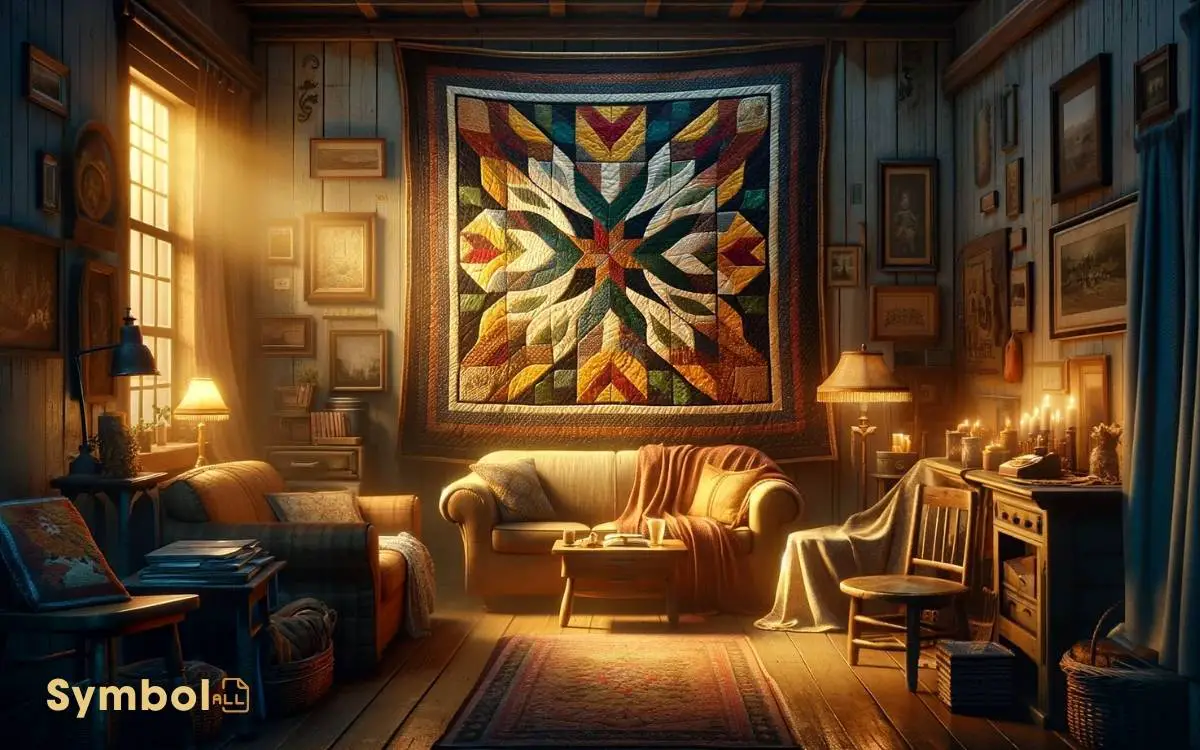What Do the Quilts Symbolize in Everyday Use? Heritage!
In “Everyday Use,” the quilts symbolize the complex layers of heritage and identity. You’ll notice they’re not just blankets; they’re a vivid intersection of cultural appreciation and appropriation.
They highlight a generational divide, with one character viewing them as practical, sentimental links to ancestors, while another sees them as aesthetic objects removed from their utilitarian roots.
These quilts stitch together stories of family bonds, embodying both the skill of the artisans and the emotional narratives of those who made them. They serve as a battleground for interpreting heritage, showing how deeply personal and contested cultural legacies can be.
This nuanced exploration invites a deeper understanding into the tangible and intangible value of cultural artifacts.

Key Takeaways
Heritage and Identity
Alice Walker’s ‘Everyday Use’ poignantly explores the nuanced conflict of heritage and identity through its characters’ divergent perceptions of cultural artifacts.
You’ll find that Mama and Maggie view heritage as a living, breathing aspect of their daily lives, something to be used, appreciated, and passed down. Their connection to their belongings is tactile and practical, yet deeply sentimental.
Conversely, Dee’s approach to heritage is more superficial and aesthetic. She sees cultural artifacts as objects to be admired for their historical and artistic value, rather than for their practical use.
This dichotomy raises questions about the true nature of heritage: Is it something to be preserved in its pristine state, or is it a dynamic, evolving part of identity, meant to be integrated into everyday life?
The Value of Handicraft
In ‘Everyday Use,’ the handicrafts symbolize not merely the preservation of heritage but an intimate connection to the ancestral skills and lives that produced them.
These artifacts, especially the quilts, aren’t just fabric stitched together; they’re a tapestry of stories, lessons, and love passed down through generations.
You see, each thread, each pattern holds a narrative of resilience, ingenuity, and the tactile memory of hands long gone.
Thus, the value of these handicrafts transcends their aesthetic appeal or utilitarian function. They embody a living history, a tangible link to the past that grounds one’s identity in the present.
To hold them is to hold a piece of history, a testament to the enduring spirit of those who came before.
Generational Divide
How does the clash between traditional values and modern aspirations manifest within the family dynamics of ‘Everyday Use,’ leading to a palpable generational divide?
This divide is vividly illustrated through the contrasting characters of Mama, deeply rooted in her heritage, and her daughter Dee, who seeks to redefine her identity through a more contemporary lens.
Dee’s desire for the quilts, not as utilitarian objects but as symbols of cultural heritage to be displayed, starkly opposes Mama’s view of them as embodiments of familial legacy and everyday use.
This conflict highlights a broader theme of how generational shifts influence the perception of cultural artifacts.
Dee’s approach underscores a detachment from the practical aspects of her heritage, revealing a chasm between preserving traditions and reinterpreting them for modern identity construction.
Cultural Appropriation
You must first understand the nuances of cultural appropriation, a concept that permeates the narrative of ‘Everyday Use‘.
The story’s quilts emerge as profound cultural symbols, encapsulating the essence of heritage and tradition.
This appropriation significantly impacts how heritage is perceived, challenging the authenticity of cultural expressions within a modern context.
Defining Cultural Appropriation
Cultural appropriation involves the adoption or use of elements from one culture by members of another, often without understanding or respecting the original context and significance.
This phenomenon can blur the lines between homage and exploitation, leading to significant cultural and ethical dilemmas.
As you delve into this topic, it’s crucial to recognize that appropriation occurs within a complex web of power dynamics.
Typically, it’s those from a dominant culture who appropriate from marginalized groups, stripping elements of their inherent meanings and reducing them to exotic or trendy commodities.
This process not only disrespects the source culture but also perpetuates a cycle of misunderstanding and erasure.
Understanding these nuances is key to fostering a more respectful and informed interaction with cultures different from your own.
Quilts as Cultural Symbols
In ‘Everyday Use,’ the quilts emerge as potent symbols of cultural heritage and identity, begging the question of whether their appropriation strips them of their intrinsic value and meaning.
You’ll find these quilts aren’t merely fabric stitched together; they’re repositories of memories, experiences, and skills passed down through generations.
Their appropriation, however, risks transforming these deeply personal and culturally significant artifacts into mere aesthetic objects, devoid of their rich history and significance.
| Aspect | Impact |
|---|---|
| Cultural Heritage | Diminished authenticity and connection. |
| Personal Identity | Erosion of individual and familial legacy. |
| Artistic Value | Reduction to decorative items. |
| Historical Significance | Loss of narrative and context. |
| Community Bonds | Weakening of communal ties and traditions. |
This transformation underscores a critical tension between cultural preservation and cultural appropriation, compelling you to ponder the true cost of detaching such artifacts from their origins.
Impact on Heritage Perception
The appropriation of cultural artifacts like quilts in ‘Everyday Use’ drastically alters the way heritage is perceived, shifting it from a deeply rooted familial legacy to a mere object of aesthetic value.
This transformation underlines a crucial critique of how modern society often misunderstands and misrepresents cultural symbols.
When you view these quilts merely as art or decor, you’re stripping away their rich historical narratives and the hands that crafted them. It’s a stark reminder of the ease with which cultural depth can be flattened into superficial tokens.
This shift not only dilutes the original meanings and values embedded in these items but also challenges the very notion of cultural ownership and identity.
In essence, it’s a call to reevaluate our approach to cultural heritage, urging a move towards preservation rather than appropriation.
Family Bonds
In ‘Everyday Use,’ you’ll find that heirlooms serve not just as objects of aesthetic value but as vital links between generations, encapsulating shared memories and cultural heritage.
These artifacts strengthen family ties by embodying the collective identity and history of the family.
Thus, the preservation of cultural heritage through these heirlooms is a testament to the enduring nature of family bonds.
Heirlooms Link Generations
How do heirlooms serve as tangible links across generations, fostering deep family bonds and continuity within the narrative of ‘Everyday Use’?
In Alice Walker’s story, quilts embody the heritage and lineage of the characters, acting as repositories of familial history.
You observe how these quilts, stitched by the hands of ancestors, aren’t merely artifacts but encapsulate stories, struggles, and triumphs of previous generations.
They’re symbols of identity, connecting individuals to their roots and providing a sense of belonging. Through the quilts, Walker illustrates the profound connection between past and present, emphasizing that preserving these heirlooms is integral to maintaining familial unity.
Thus, heirlooms in ‘Everyday Use’ are crucial for linking generations, ensuring that the essence of family history isn’t lost but cherished and continued.
Shared Memories, Strengthened Ties
Shared memories, through the prism of family heirlooms, not only connect us to our past but also strengthen the ties that bind us to our relatives.
The quilts in “Everyday Use” serve as a tangible representation of these bonds, embodying the experiences and stories of those who crafted them.
| Aspect | Impact |
|---|---|
| Craftsmanship | Highlights the skill and care invested by ancestors. |
| Usage | Demonstrates the functional aspect of heritage. |
| Preservation | Reflects the desire to maintain family legacy. |
| Identity | Acts as a marker of familial and personal history. |
This analysis underscores the quilts’ role as more than mere objects; they are symbols of familial unity, carrying the essence of shared lives and aspirations.
Cultural Heritage Preservation
Building on the understanding of quilts as symbols of familial unity, let’s explore how they also serve as vessels for preserving cultural heritage within family bonds.
These quilts, meticulously stitched together with fragments of the family’s past, aren’t merely decorative items; they’re repositories of stories, traditions, and values handed down through generations.
Each patch, each thread, embodies the struggles, joys, and everyday lives of ancestors, making the quilts tangible links to the past.
As you engage with these artifacts, you’re not just observing a piece of fabric; you’re connecting with the lineage and the collective memory of a family.
This connection underscores the vital role that quilts play in the preservation of cultural heritage, ensuring that the essence of who we are and where we come from remains alive and cherished within family bonds.
The Art of Storytelling
Alice Walker masterfully utilizes the art of storytelling in ‘Everyday Use’ to explore complex themes of heritage, identity, and familial bonds.
Through her narrative, she invites you to delve into the lives of her characters, making you ponder the deeper meanings behind their actions and choices.
The art of storytelling in this context serves several purposes:
- Engages the reader by weaving a compelling narrative.
- Illuminates character dynamics, revealing deeper insights into their personalities and motivations.
- Enhances thematic exploration, allowing for a nuanced discussion of heritage and identity.
- Facilitates emotional connection, drawing readers closer to the characters’ experiences.
- Promotes cultural reflection, encouraging a reevaluation of one’s own views on heritage and familial ties.
Material Vs. Symbolic Worth
In ‘Everyday Use,’ the contrast between material and symbolic worth is vividly portrayed through the characters’ varying perceptions of heritage.
You see, the quilts serve as a focal point for this exploration, embodying both the tangible and intangible attributes of heritage. You see, the quilts serve as a focal point for this exploration, embodying both the tangible and intangible attributes of heritage. Much like tomb decoration items and symbols, which encapsulate the essence of a person’s legacy and beliefs, these quilts tell stories that are deeply rooted in cultural traditions. They go beyond mere functionality, becoming vessels of memory and identity, passed down through generations as enduring artifacts of human expression.
| Character | Views on Quilts | Perception of Heritage |
|---|---|---|
| Mama | Utilitarian use | Living, breathing tradition |
| Dee | Artifacts | Static, to be observed |
| Maggie | Emotional connection | A part of daily life |
Through this lens, the narrative scrutinizes the dichotomy between seeing cultural items as mere physical entities versus understanding their deeper historical and emotional resonance.
The quilts, thus, are not just blankets; they are repositories of stories, skills, and spirits passed down through generations, highlighting the profound disparity in how characters connect with their ancestry.
Resistance and Acceptance
The narrative deftly explores resistance and acceptance within the framework of heritage, revealing how each character’s stance shapes their interaction with their cultural legacy.
- Dee’s resistance to her immediate cultural heritage in favor of a broader African identity.
- Mama’s acceptance of her roots, reflected in her simple, unpretentious lifestyle.
- Maggie’s quiet acceptance and internalization of family traditions.
- The quilts symbolize a bridge between past and present, where acceptance and resistance meet.
- The contrasting attitudes towards heritage underscore the complex dynamics of identity formation.
This analysis shows that understanding and appreciating one’s heritage isn’t a straightforward journey. It’s marked by personal interpretations, which can either alienate or deeply connect individuals to their roots.
Tradition Vs. Modernity
Exploring the narrative further, one finds that ‘Everyday Use’ poignantly juxtaposes tradition and modernity, revealing the nuanced tensions that define personal and cultural identity.
Alice Walker masterfully showcases this through the contrasting perspectives of her characters, primarily focusing on the quilts as symbols of heritage and the evolving interpretation of their value.
| Aspect | Tradition | Modernity |
|---|---|---|
| Value | Sentimental | Aesthetic |
| Usage | Practical | Decorative |
| Perspective | Mama & Maggie | Dee |
| Identity | Rooted in heritage | Shaped by new ideals |
| Preservation | Through use | Through preservation |
This table summarizes the dichotomy between embracing one’s roots and adapting to new cultural landscapes. It’s a compelling reflection on how the past shapes, but does not necessarily dictate, one’s modern identity.
Memory and Preservation
Delving into the theme of ‘Memory and Preservation’ reveals how Alice Walker intricately weaves the past into the present, illustrating that personal and collective histories aren’t merely to be remembered but actively preserved through tangible and intangible cultural artifacts.
In ‘Everyday Use,’ this preservation is vividly showcased through:
- Quilts embodying generations of family stories.
- The butter churn that represents daily traditions and labor.
- Oral stories that breathe life into family history.
- The family home as a physical marker of heritage.
- Photographs capturing moments frozen in time.
Walker’s narrative suggests that these artifacts do more than recall the past; they serve as a bridge to future generations, ensuring that the essence of one’s heritage isn’t lost but continues to inform and enrich the living.
Everyday Use Interpreted
Alice Walker’s ‘Everyday Use’ offers a nuanced exploration of cultural identity and heritage, challenging readers to consider the varied interpretations of everyday objects within the context of African American history and experience.
You’re invited to delve into the complexities of how heritage and culture are perceived and valued differently among individuals within the same community.
The quilts, central to the narrative, aren’t merely artifacts but embody the legacy and ongoing life of the family’s ancestors.
They symbolize the intersection of past and present, suggesting that heritage isn’t static but alive and evolving.
This interpretation underscores the idea that understanding and honoring one’s heritage involves integrating it into daily life, not merely preserving it as a relic of the past.
Walker’s story prompts you to reflect on your own perspectives on cultural heritage and its place in everyday life.
Conclusion
In ‘Everyday Use,’ quilts emerge as multifaceted symbols, embodying the essence of heritage, identity, and the complex interplay between tradition and modernity.
Aren’t they more than mere blankets? Indeed, they represent the intricacies of family bonds, cultural appropriation, and the generational divide, serving as a canvas for memory and preservation.
Through these textiles, Alice Walker masterfully critiques and celebrates the nuances of everyday life, urging us to reconsider what we value and why. Ultimately, the quilts transcend their material existence, becoming a profound commentary on the very fabric of our lives.






